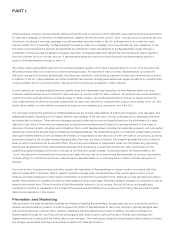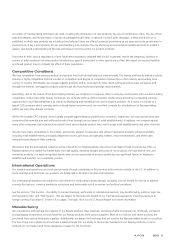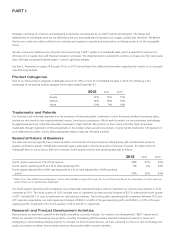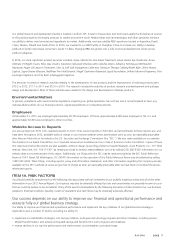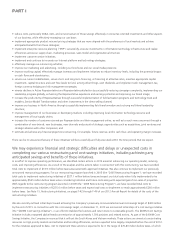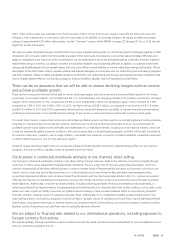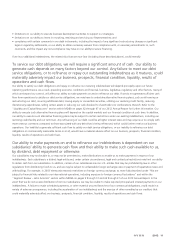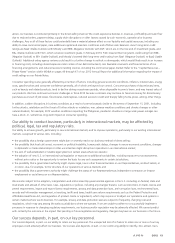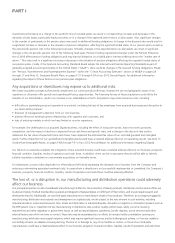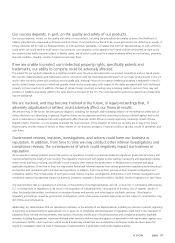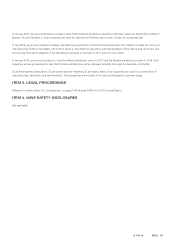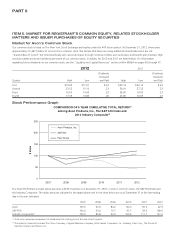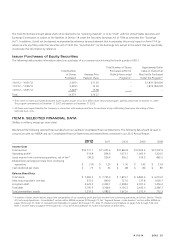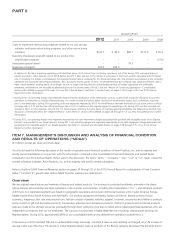Avon 2012 Annual Report Download - page 21
Download and view the complete annual report
Please find page 21 of the 2012 Avon annual report below. You can navigate through the pages in the report by either clicking on the pages listed below, or by using the keyword search tool below to find specific information within the annual report.PART I
develop and retain other highly qualified personnel. Competition for these employees can be intense and our ability to hire, attract and
retain them depends on our ability to provide competitive compensation. We may not be able to attract, assimilate, develop or retain
qualified personnel in the future, and our failure to do so could adversely affect our business, including the execution of our global business
strategy. For example, since 2011, there have been many changes to the Company’s senior management, including a new chief executive
officer and chief financial officer. Any failure by our management team to perform as expected may have a material adverse effect on our
business, prospects, financial condition and results of operations. This risk may be exacerbated by the uncertainties associated with the
implementation of our stabilization strategies and restructuring and cost-savings initiatives.
We face intense competition and can make no assurances about our ability to overcome our
competitive challenges.
We face intense competition from competing products in each of our lines of business, in both the domestic and international markets.
Worldwide, we compete against products sold to consumers by other direct selling and direct sales companies and through the Internet, and
against products sold through the mass market and prestige retail channels. We also face increasing competition in our developing and
emerging markets, particularly Brazil.
Within the direct-selling channel, we compete on a regional, and often country-by-country, basis with our direct selling competitors. There
are also a number of direct selling companies that sell product lines similar to ours, some of which also have worldwide operations and
compete with us globally. Unlike most other beauty companies, we compete within a distinct business model where providing a compelling
earnings opportunity for our Representatives is as critical as developing and marketing new and innovative products. Therefore, in contrast
to a typical consumer packaged goods (“CPG”) company which operates within a broad-based consumer pool, we must first compete for a
limited pool of Representatives before we reach the ultimate consumer.
Direct sellers compete for representative or entrepreneurial talent by providing a more competitive earnings opportunity or “better deal”
than that offered by the competition. Representatives are attracted to a direct seller by competitive earnings opportunities, often through
what are commonly known as “field incentives” in the direct selling industry. Competitors devote substantial effort to finding out the
effectiveness of such incentives so that they can invest in incentives that are the most cost effective or produce the better payback. As the
largest and oldest beauty direct seller, Avon’s business model and strategies are often highly sought after, particularly by smaller and more
nimble competitors who seek to capitalize on our investment and experience. As a result, we are subject to significant competition for the
recruitment of Representatives from other direct selling or network marketing organizations. It is therefore continually necessary to innovate
and enhance our direct selling and service model as well as to recruit and retain new Representatives. If we are unable to do so, our business
will be adversely affected.
Within the broader CPG industry, we compete against large and well-known cosmetics and fragrances companies that manufacture and sell
broad product lines through various types of retail establishments. In addition, we compete against many other companies that manufacture
and sell in more narrow beauty product lines sold through retail establishments. This industry is highly competitive, and some of our
principal competitors in the CPG industry are larger than we are and have greater resources than we do. Competitive activities on their part
could cause our sales to suffer. We have many competitors in the highly competitive gift and decorative products and apparel industries
globally, including retail establishments, principally department stores, gift shops and specialty retailers, and direct-mail companies
specializing in these products. Our principal competition in the highly competitive fashion jewelry industry consists of a few large companies
and many small companies that sell fashion jewelry through retail establishments.
The number of competitors and degree of competition that we face in the beauty and related products industry varies widely from country
to country. If our advertising, promotional, merchandising or other marketing strategies are not successful, if we are unable to improve our
product mix and offer new products that represent technological breakthroughs and are aligned with local preferences, if we do not
successfully manage the timing of new product introductions or the profitability of these efforts, if we are unable to improve our
Representative Value Proposition (“RVP”), or if for other reasons our Representatives or end customers perceive competitors’ products as
having greater appeal, then our sales and results of operations will be adversely affected.
Our ability to improve our financial performance depends on our ability to anticipate and
respond to market trends and changes in consumer preferences.
Our ability to improve our financial performance depends on our ability to anticipate, gauge and react in a timely and effective manner to
changes in consumer spending patterns and preferences for beauty and related products. We must continually work to develop, produce


